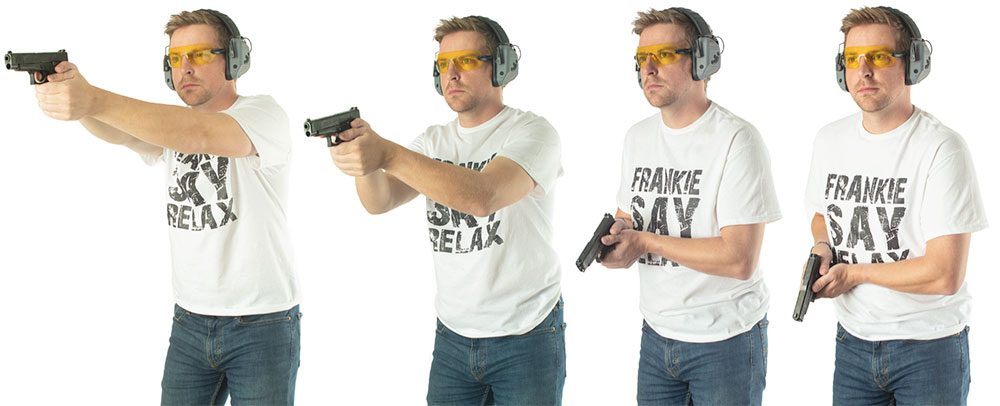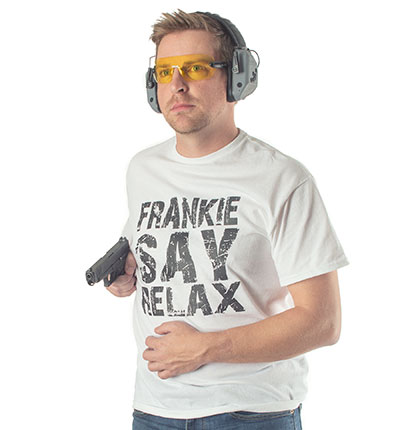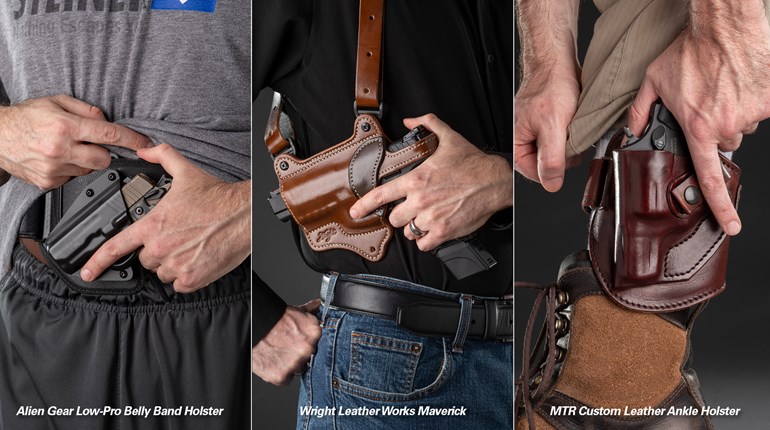
A question came up on the range, “How do I move my handgun when I’m transitioning between multiple targets?” A quick explanation turned into a deeper exploration of how the perceived circumstances you’re facing at the moment determine the handgun’s movement before the shot is pressed.
I’ve always believed skills and tactical training should be from the street in, not from the range out. When we carry a handgun, we operate in the real world of consequences, and our concepts of gun-handling—both on the street and on the range—must match our needs. Additionally, I’ve always believed we need to apply what humans can do and, perhaps as importantly, avoid practicing what we can’t do when under duress. It’s vital to train with concepts and methods allowing us to move as naturally as possible with the handgun, rather than creating specific “techniques” for specific tasks we are not likely to remember when under life-threatening circumstances. And, sometimes, accepted techniques we do remember can hinder our ability to respond well to imminent threats.
Let’s talk about the truth of effectively working with a handgun while also supporting the ability to quickly make the shot. After learning the fundamentals of shooting, most of us are taught to handle and maneuver our firearms through the use of ready positions. I’m not a fan of rigid, formal ready positions, e.g., low-ready, high-ready, compressed ready, high-depressed ready, modified-inverted ready, covert-tactical ready taught by “Big Jim” (whose neighbor used to be a Navy SEAL), etc.
Ready positions tend to result in a stiff posture and are too often rigidly held by the shooter. Shooters on the line are seen tightly gripping their firearms, their war-faces on, shoulders and elbows locked, with knees bent and spines forward, all tensely waiting for the signal to shoot. What they are not ready for is movement.
Problematically, muscle tension in the limbs and body slows movement when quickness is required. Relaxed muscles are ideal for rapid reactions to stimuli (either a timer’s beep or the decision to respond with deadly defensive force). When the muscles of a limb are tense, movement requires more effort to push through, eating more time than just quickly moving the limb from a relaxed state.
Think about trying to hit a fly as hard as you can. It will never happen because you’re too slow, working against yourself. Your only hope is quick movement. Fighters know this; a boxer holds his hands up at face level, elbows protecting his ribs with relaxed arms. Sensing an opening, the hand and arm are relaxed as they shoot forward with the feet and body moving simultaneously to support the strike. It’s only in the last few inches of the strike that the hand tightens, and the muscles of the arm and shoulder stiffen to deliver the force through the target. The same goes for moving a handgun or any weapon. Relaxed preparation, quick movement, then tension when it’s needed is the process for effectively hitting a fly, punching an opponent and efficiently moving a handgun to target.
The handgun is held in a relaxed, but secure, grip prior to movement. This relaxed grip includes the fundamentals of gripping with the shooting-hand high on the backstrap, trigger finger indexed and the fingers holding the handgun grip. If the support hand is on the pistol at this moment, the fingers are under the trigger guard. The relaxed shooting hand needs no significant adjustment if instantly required to respond to a signal to fire or an imminent deadly threat, yet can be held indefinitely in this position with little or no fatigue.

Now, let’s think about holding a handgun and making the decision to direct the muzzle toward a threat whose behavior indicates a very likely—but not yet imminent—deadly threat. Far too often we’ve seen police officers standing for minutes in a very tense, high-ready position while shouting commands at an uncooperative, hostile, armed subject some distance away. The fatigue from holding that position for an extended time becomes enormous. If that subject now charges the officer, will that fatigue and muscle rigidity affect how well the officer shoots if that comes next? Common experience tells us a fatigued shooter tends to underperform.
So, if not a ready stance, what do I do with my firearm until I make the decision to shoot? Just as my hands in a physical fight will find the position I need them to be in while relaxed and ready to act, so, too, will my hands, shoulders and body be relatively relaxed when readying to respond with quick, accurate gunfire. My handgun’s home when out of the holster generally begins from around my solar plexus. This roughly corresponds to the same level the handgun is brought up to in a proper draw stroke from a holster prior to laterally transitioning toward the target. This makes it a natural and trained ready carry from which to consistently direct the firearm at a target. Again, everything is relaxed—until it isn’t.
The handgun “at home” is consciously held in a safe direction. Reacting to a signal or perception of imminent deadly threat, my handgun punches forward and up to my eye-target line (the imaginary line between our eyes and the target), my grip tightening, while my shoulders support my firing process as the handgun comes to full extension.
In a threatening situation, a realistic ready position of the handgun directly reflects my circumstances and perception of imminent deadly threat. I think of the firearm as floating where it needs to be, changing from moment-to-moment to support my needs. With the muzzle pointed toward the likely threat area, sometimes it floats a few inches forward and higher than the solar plexus. At other times, it will float even more forward and just under my direct line of sight, ready to be punched out to full extension. When there is an immediate need to fire, the handgun moves to extension with grip and shoulders tightened, the sights interrupting my eye-target line, catching and confirming my front sight/sight picture, and I press the shot.
Rather than thinking about and assuming a specific ready position, the handgun moves in and out from my body, and toward or away from my eye-target line as the situation demands. My ready position is not something I get into. Rather, my perception of threat causes the handgun to move to support what I need at that moment to protect myself.
Transitioning Between Multiple Targets
Fundamentally, when we transition from one target to another in rapid fire, the rule is that the eyes move first, then body and gun. Many beginner shooters move their eyes and guns at the same time, taking a relatively long time to transition from target to target. This ends up as moving slow, shooting fast, often missing the shot. A better concept is: Eyes first, move crisply, shoot sure. Transitioning the handgun quickly between the targets, then using the extra time to get the sure hit is more efficient and more likely to get an accurate hit in the time you have. Moving the handgun from one target to the next requires the same concepts as a ready position: the pistol floats to the most natural and efficient manner to accomplish the task more quickly.

Whether the firearm is moved in or out from your body while transitioning between two targets is based on where the pistol is needed and how to get it there in-time, on-time to make the needed critical hit. This is explained through the point-within-a-circle theory. Think about the children’s game, “Crack the Whip,” where the kid at the end of the line is thrown outward while the one close to the circle’s center comfortably pivots at the circle’s center. Simply stated, with two objects moving around the point of a circle’s center while maintaining the same relative position to each other and the circle center, the farther from the center an object is traveling, the faster its speed compared to the object closer to the circle’s center.
When transitioning between two equally threatening targets standing close together, say, 3 feet apart, 8 yards away, the distance of the movement of the firearm from the first to the second target is minimal. Retracting the pistol while pivoting may result in taking more time to target, creating a slower hit. Generally, you’ll find it more natural and quicker to keep the handgun extended while moving crisply between two targets in proximity to each other.
Now let’s say those targets 8 yards away are 20 yards apart. Keeping our handgun at full extension as we pivot from one target to another, the pistol will not only take longer to get there because it must move farther around as the body pivots, it will also require a huge effort to decelerate that firearm to avoid over-swinging past the target. This eats up time we may not have.
Allowing the gun to move naturally as we pivot facilitates transitioning between widely spaced targets. We’ll generally find the handgun naturally floats in closer to our bodies as we pivot, then is rapidly pressed out at the target to confirm sight picture and press the trigger. Like a figure skater pulling their hands and free leg into their body, causing them to start spinning on one foot to accelerate, we pivot more quickly to the second target if the pistol floats in toward our bodies as we begin our turn. We then extend out when almost facing the target. Punching out, or extending the handgun increases deceleration, allowing for a quicker hit.
There is wisdom in the saying, “There are many ‘a way’ to do things, but few ‘the way.’” Rather than being taught a correct ready position—beneficial only for a rangemaster on a square range—or the proper method of moving your handgun while transitioning between targets, our bodies are already programmed to efficiently react and move.
While holding a device that is designed to repeatedly explode at arm’s length may be unnatural, how we use our firearm should align with our primal movement patterns and safety needs based on our perception of imminent deadly threat (or need to quickly shoot). This creates efficiency. Once we let ourselves do what we naturally do, we’re freed from having to remember the “right” way to do it, especially when we are scared and focusing on trying to live through the next few moments. Moving the pistol organically, from relaxed to tense, efficiently using the time we have, getting the hits we need in-time, on-time, is the key to success in shooting, regardless of the circumstances we find ourselves in. Wherever our handgun is being held is simply a moment in a continuum of movement from “relaxed at home” to full extension and firing.
The answer to the original question, “How do I move my handgun when I’m transitioning between multiple targets?” is: Naturally and efficiently move according to the demands on your time as dictated by the circumstances to get the hit you need.






































